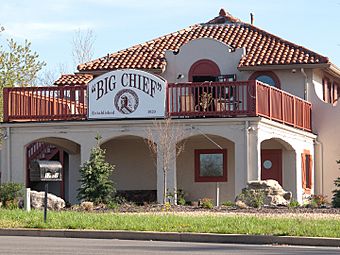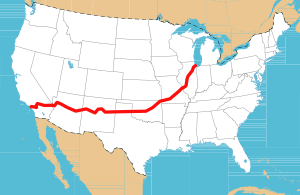Big Chief Restaurant facts for kids
Quick facts for kids |
|
|
Big Chief Restaurant
|
|

Big Chief Restaurant, Wildwood, Missouri
|
|
| Location | 17352 Old Manchester Road Wildwood, Missouri |
|---|---|
| Built | 1928 |
| Architect | Walter H. Petring Highway Hotel Corporation |
| Architectural style | Mission Revival |
| Website | Big Chief home page |
| NRHP reference No. | 03000181 |
| Added to NRHP | April 2, 2003 |
The Big Chief Restaurant, located in Wildwood, Missouri, is a historic building that first opened in 1928. Today, it's known as the Big Chief Roadhouse. It was once part of a larger tourist camp called the Big Chief Highway Hotel. This camp offered places for travelers to stay overnight. It was built right when the famous U.S. Route 66 opened near Pond, Missouri (which is now part of Wildwood).
After Route 66 was changed to go around Pond, the business faced tough times. During World War II, it even provided housing for government workers. Over time, the original cabins were taken down. The restaurant building was used for other businesses for a while. But in the 1990s, it reopened as a restaurant.
Contents
The Story of U.S. Route 66
The opening of U.S. Route 66 was a big deal for travel in America. This highway allowed people to drive all the way from Chicago to Santa Monica, California. As more and more people started exploring the country by car, new restaurants and places to stay popped up everywhere along the route. These places were often called tourist courts, tourist camps, or motels.
Big Chief's Start on Route 66
When it was decided that Route 66 would pass through the small community of Pond, plans were made for the Big Chief Highway Hotel complex. An article from 1929 mentioned Walter H. Petring as the person in charge of planning these tourist camps. He wanted to build a chain of camps along Route 66, each about "one day's drive apart."
Some people also credit William Clay Pierce with developing the Big Chief and the idea for a chain of these places. However, when researchers looked into it for the NRHP, they didn't find proof that a whole chain of Big Chief camps was ever built.
The Big Chief tourist camp opened in 1928. It had 62 units for travelers and cost a lot of money to build. The buildings were designed in the Mission Revival architecture style, which often features stucco walls and bell towers. Each unit cost $1.50 a night to rent. They were arranged in a way that looked like a rectangle, with one side open to the highway.
The Big Chief restaurant was a two-story building with a bell tower. It was a fancy place, much more formal than the small diners usually found at tourist camps. It served lunch and dinner. It even had a special area for parties and banquets.
An old newspaper article from 1928 said that each unit came with its own garage for the traveler's car. There was a locked gate to keep out unwanted visitors. The camp also had a gas station and fun areas for kids and adults, including a concrete dance floor.
Changes After 1932
In 1932, U.S. Route 66 was changed and no longer went through Pond. This made business harder for the Big Chief. To adapt, the restaurant added "The Tap" room for drinks after the end of Prohibition in 1933.
The Big Chief also helped out during World War II. It provided housing for people who worked at nearby government facilities. These facilities were important for supporting the war effort.
The restaurant closed in 1949. Marco and Rose Aceto bought the property. They removed the bell tower and used the building for different businesses. They had planned to reopen the restaurant, but it never happened. The original cabins were eventually torn down.
In the 1990s, G. Todd DeVille bought the remaining property. The restaurant reopened in 1995 as the Big Chief Dakota Grill. Today, it's known as the Big Chief Roadhouse. It's the only part of the original 1928 complex that is still standing.
Becoming a Historic Place
Because of its history and unique architecture, the Big Chief Restaurant was added to the National Register of Historic Places in 2003. This means it's recognized as an important historic site.




